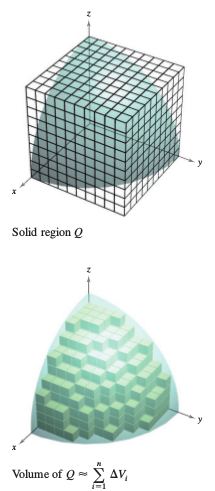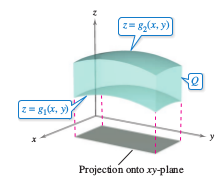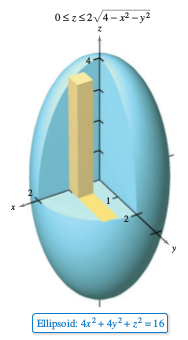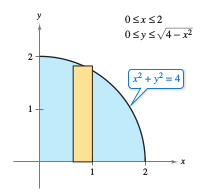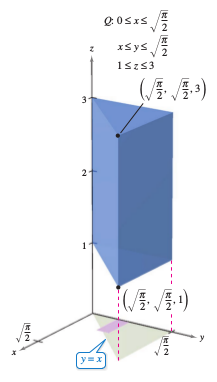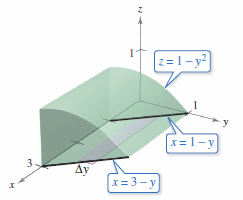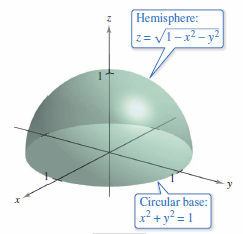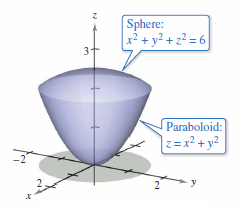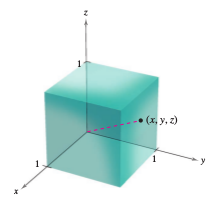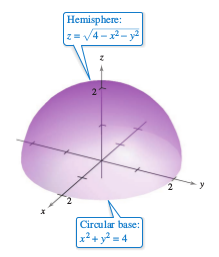Calculus III 14.06 Triple Integrals and Applications
| Previous | Calculus III 14.05 Surface Area |
| Next | Calculus III 14.07 Triple Integrals in Other Coordinates |
Contents
- 1 14.06 Triple Integrals and Applications
- 1.1 Triple Integrals
- 1.1.1 Definition 14.6.1 Triple Integral
- 1.1.2 Theorem 14.6.1 Fubini's Theorem[1] On \(dz \: dy \: dx\) Integration Order
- 1.1.3 Example 14.6.1 Evaluating a Triple Iterated Integral
- 1.1.4 Example 14.6.2 Using a Triple Integral to Find Volume
- 1.1.5 Example 14.6.3 Changing the Integration Order
- 1.1.6 Example 14.6.4 Determining the Integration Limits
- 1.2 Mass Center and Inertia Moments
- 1.1 Triple Integrals
- 2 Internal Links
14.06 Triple Integrals and Applications
- Use a triple integral to find the volume for a solid region.
- Find the mass center and inertia moments for a solid region.
Triple Integrals
|
|
The rules for double integrals can be extended to triple integrals. Consider a function \(f\) with three variables that is continuous over a bounded solid region \(Q\). Enclose \(Q\) with equal sized boxes and form an inner partition with all the boxes that lay entirely within \(Q\), as shown in Figure 14.6.1. The volume for the \(i\)th box is
The norm \(\| \Delta \|\) for the partition is the length for the longest diagonal for the \(n\) boxes in the partition. Choose a point \((x_{i},y_{i},z_{i})\) in each box and form the Riemann sum
Taking the limit at \(\| \Delta \| \rightarrow 0\) produces Definition 14.6.1. Definition 14.6.1 Triple IntegralIf \(f\) is continuous over a bounded solid region \(Q\), then the triple integral for \(f\) over \(Q\) is defined as
provided the limit exists. The volume for the solid region \(Q\) is given by
Theorem 14.2.1 properties can be restated for triple integrals.
The region \(Q\) is the union between two nonoverlapping solid subregions \(Q_{1}\) and \(Q_{2}\). If the solid region \(Q\) is simple, then the triple integral \( \int \int_{Q} \int f(x,y,z) \: dV\) can be evaluated with an iterated integral by choosing one from six possible integration orders:
|
Theorem 14.6.1 Fubini's Theorem[1] On \(dz \: dy \: dx\) Integration Order
Left \(f\) be continuous on a solid region \(Q\) defined by
| \( a \leqslant x \leqslant b,\) |
| \(h_{1}(x) \leqslant y \leqslant h_{2}(x), \) |
| \(g_{1}(x,y) \leqslant z \leqslant g_{2}(x,y) \) |
where \(h_{1}, \: h_{2}, \: g_{1}\) and \(g_{2}\) are continuous functions. This produces,
- $$ \int \int_{Q} \int f(x,y,z) \: dV = \int_{a}^{b} \int_{h_{1}(x)}^{h_{2}(x)} \int_{g_{1}(x)}^{g_{2}(x)} f(x,y,z) \: dz \: dy \: dx. $$
To evaluate a triple iterated integral in the order \( dz \: dy \: dx\), hold both \(x\) and \(y\) constant for the innermost integration. Then, hold x constant for the second integration.
Example 14.6.1 Evaluating a Triple Iterated Integral
Evaluate the triple iterated integral
- $$ \int_{0}^{2} \int_{0}^{x} \int_{0}^{x+y} e^{x}(y+2z) \: dz \: dy \: dx. $$
Solution For the first integration, hold \(x\) and \(y\) constant and integrate with respect to \(z\).
| $$\int_{0}^{2} \int_{0}^{x} \int_{0}^{x+y} e^{x}(y+2z) \: dz \: dy \: dx $$ | $$= \left. \int_{0}^{2} \int_{0}^{x} e^{x}(y+z^{2}) \right]_{0}^{x+y} \: dy \: dx $$ |
| $$= \int_{0}^{2} \int_{0}^{x} e^{x}(x^{2}+3xy+2y^{2}) \: dy \: dx $$ |
For the second integration, hold \(x\) constant and integrate with respect to \(y\).
| $$ \int_{0}^{2} \int_{0}^{x} e^{x}(x^{2}+3xy+2y^{2}) \: dy \: dx$$ | $$= \int_{0}^{2} \left[ e^{2} \left( x^{2}y+ \frac{3xy^{2}}{2} + \frac{2y^{3}}{3} \right) \right]_{0}^{x} \: dx $$ |
| $$= \frac{19}{6} \int_{0}^{2} x^{3} e^{x} \: dx$$ |
For the third integration, integrate with respect to \(x\).
| $$ \frac{19}{6} \int_{0}^{2} x^{3} e^{x} \: dx $$ | $$= \frac{19}{6} \left[ \vphantom{\frac{1}{2}} e^{x}(x^{3}-3x^{2}+6x-6) \right]_{0}^{2}$$ |
| $$= 19 \left( \frac{e^{x}}{3}+1 \right) \approx 65.797$$ |
|
|
To find the limits for a particular integration order determine the innermost limits, which may be functions for the outer two variables. Then, by projecting the solid \(Q\) onto the coordinate plane for the outer two variables, determine their integration limits by the methods used for double integrals. For instance, to evaluate
first determine the limits for \(z\); the integral then has the form
By projecting the solid \(Q\) onto the \(xy\)-plane the limits for \(x\) and \(y\) become apparent, as shown in Figure 14.6.2. |
Example 14.6.2 Using a Triple Integral to Find Volume
|
|
Find the volume for the ellipsoid given by
Solution Because \(x\), \(y\), and \(z\) are equally represented in the equation, any integration order can be used with equal difficulty. The integration order here will be \(dz, \: dy, \: dx\) will be chosen. The ellipsoid lies evenly about the origin, as shown in Figure 14.6.3. Integrate the first octant and multiply by eight to find the total volume. Determining the bounds for \(z\) yields
The bounds for \(x\) and \(z\)
and
as shown by examining the cross-section displayed in Figure 14.6.4. This produces the volume for the ellipsoid
|
Example 14.6.3 Changing the Integration Order
|
|
Evaluate
Solution Note the second integration in the given order is
which is not an elementary function. To avoid this problem, change the integration order to \(dz \: dx \: dy\), so that \(y\) is the new outer variable. The bounds for the solid region \(Q\) are
Projecting \(Q\) in the \(xy\)-plane yields the bounds
and
as shown in Figure 14.6.5. Evaluating the triple integral using the new order \(dz \: dx \: dy\) produces
|
Example 14.6.4 Determining the Integration Limits
|
|
For solid regions a, b, and c, set up a triple integral for each volume.
Solution
|
Mass Center and Inertia Moments
Consider a solid region \(Q\) whose density is given by the density function \(\bf{\rho}\). The mass center for a solid region \(Q\) with mass \(m\) is given by \((\bar{x},\bar{y},\bar{z})\), where
| $$m $$ | $$= \int \int_{Q} \int \rho (x,y,z) \: dV $$ | Mass for the solid |
| $$ M_{yz} $$ | $$= \int \int_{Q} \int x \rho (x,y,z) \: dV $$ | First moment about \(yz\)-plane |
| $$ M_{xz} $$ | $$= \int \int_{Q} \int y \rho (x,y,z) \: dV $$ | First moment about \(xz\)-plane |
| $$ M_{xy} $$ | $$= \int \int_{Q} \int z \rho (x,y,z) \: dV $$ | First moment about \(xy\)-plane |
| and | ||
| $$\bar{x}$$ | $$= \frac{M_{yz}}{m}, \: \bar{y} = \frac{M_{xz}}{m}, \: \bar{z} = \frac{M_{xy}}{m}.$$ |
The quantities \( M_{yz} \), \( M_{xz} \), and \( M_{xy} \) are called the first moments for the region \(Q\) about the \(yz\)-, \(xz\)-, and \(xy\)-planes, respectively.
The first moments for solid regions are taken about a plane, whereas the second moments for solids are taken about a line. The second moments (or inertia moments) about the \(x\)-, \(y\)-, and \(z\)- axes are
| $$I_{x} $$ | $$ = \int \int_{Q} \int (y^{2}+z^{2}) \rho (x,y,z) \: dV \:\:\:\: $$ | Inertia Moment about \(x\)-axis |
| $$I_{y} $$ | $$= \int \int_{Q} \int (x^{2}+z^{2}) \rho (x,y,z) \: dV \:\:\:\: $$ | Inertia Moment about \(y\)-axis |
| and | ||
| $$I_{z} $$ | $$= \int \int_{Q} \int (x^{2}+y^{2}) \rho (x,y,z) \: dV. \:\:\:\: $$ | Inertia Moment about \(z\)-axis |
For problems requiring the calculation for all three moments, considerable effort can be saved by applying the additive property for triple integrals and writing
- \(I_{x} = I_{xz} + I_{xy},\)
- \(I_{y} = I_{yz} + I_{xy},\)
and
- \(I_{z} = I_{yz} + I_{xz}\)
where \(I_{xy}, \: I_{xz}, \) and \(I_{yz}\) are
| $$I_{xy} $$ | $$ = \int \int_{Q} \int z^{2} \rho (x,y,z) \: dV $$ |
| $$I_{xz} $$ | $$= \int \int_{Q} \int y^{2} \rho (x,y,z) \: dV $$ |
| and | |
| $$I_{yz} $$ | $$= \int \int_{Q} \int x^{2} \rho (x,y,z) \: dV. $$ |
Example 14.6.5 Finding the Mass Center for a Solid Region
|
|
Find the mass center for the unit cube with a given density at the point \((x,y,z)\) is proportional to the distance squared from the origin, as shown in Figure 14.6.9.
Because the region is symmetric along all axes, any integration order will produce an integral with equal difficulty.
The first moment about the \(yz\)-plane is
Note that \(x\) can be factored from the two inner integrals because it is a constant with respect to \(y\) and \(z\). After factoring, the two inner integrals are the same as for the mass \(m\). This produces the formula for the moment about the \(yz\)-axis.
This produces
Since the solid region is symmetric along all axes, then \(\bar{x} = \bar{y} = \bar{z}\), and the mass center is
|
Example 14.6.6 Inertia Moments for a Solid Region
|
|
Find the inertia moments about the \(x\)- and \(y\)-axes for the solid region lying between the hemisphere
and the \(xy\)-plane. The density at any point \((x,y,z)\) is proportional to the distance between \((x,y,z)\) and the \(xy\)-plane.
and
where \(k\) is the density. Since the solid is symmetric along the \(x\)- and \(y\)-axes, \(I_{x}=I_{y}\).
Hence, \(I_{x}=8k \pi = I_{y}\). The moment about the \(z\)-axis is
This shows a greater resistance to rotation about the \(x\)- or \(y\)-axis than about the \(z\)-axis. |
Internal Links
Parent Article: Calculus III 14 Multiple Integration
